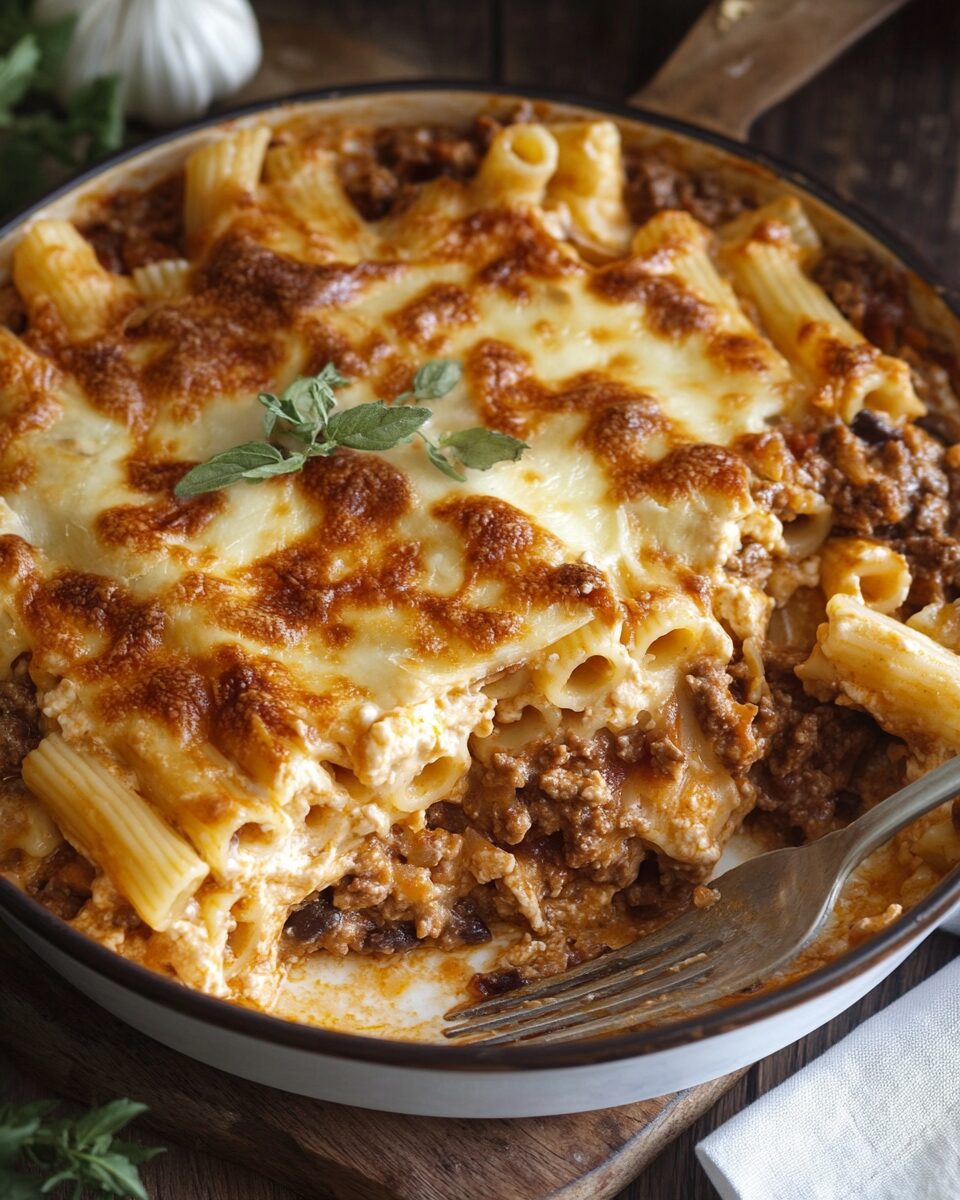Pastitsio is a beloved Greek dish known for its rich layers of seasoned meat, creamy béchamel sauce, and hearty pasta. Often referred to as Greece’s answer to lasagna, pastitsio is a staple in Mediterranean cuisine, bringing warmth and comfort to family tables across the world. Its name comes from the Italian word “pasticcio,” which means a hodgepodge or mixed dish, an apt description for this deliciously layered meal.
Full Recipe:
Ingredients:
For the Meat Sauce:
- 3 tablespoons olive oil
- 1 large yellow onion, diced
- 1 pound lean ground beef
- 1 pound lean ground lamb (or pork)
- 1/2 cup dry red wine
- 1 tablespoon minced garlic (about 3 cloves)
- 1 tablespoon ground cinnamon
- 1 teaspoon dried oregano
- 1 teaspoon fresh thyme leaves
- Pinch of cayenne pepper
- 1 can (28 ounces) crushed tomatoes
- Salt and freshly ground black pepper, to taste
For the Béchamel Sauce:
- 1 1/2 cups whole milk
- 1 cup heavy cream
- 4 tablespoons (1/2 stick) unsalted butter
- 1/4 cup all-purpose flour
- 1/4 teaspoon freshly grated nutmeg
- 1 cup plain Greek yogurt
- Salt and freshly ground black pepper, to taste
For the Pasta:
- 1 pound pasta (such as penne or ziti)
- 1 1/2 cups freshly grated Parmesan cheese
- 2 large eggs, beaten
Directions:
-
Prepare the Meat Sauce:
- Heat olive oil in a large skillet over medium heat. Add diced onions and sauté until translucent, about 5 minutes.
- Add ground beef and lamb to the skillet, cooking until browned. Drain excess fat if necessary.
- Pour in red wine, allowing it to simmer for 2 minutes.
- Stir in minced garlic, ground cinnamon, dried oregano, fresh thyme, and cayenne pepper. Cook for an additional 5 minutes.
- Add crushed tomatoes, season with salt and pepper, and let the mixture simmer over low heat for 40-45 minutes, stirring occasionally, until the sauce thickens.
-
Prepare the Béchamel Sauce:
- In a small saucepan, heat milk and heavy cream together until just simmering.
- In a separate medium saucepan, melt butter over medium heat. Whisk in flour and cook for 2 minutes, stirring constantly to form a roux.
- Gradually whisk the hot milk mixture into the roux, continuing to whisk until smooth and thickened.
- Remove from heat, stir in grated nutmeg, and season with salt and pepper. Allow the sauce to cool slightly before whisking in Greek yogurt.
-
Assemble the Pastitsio:
- Preheat the oven to 350°F (175°C).
- Cook pasta according to package instructions until al dente. Drain and return to the pot.
- Combine the meat sauce with the cooked pasta, mixing thoroughly. Allow the mixture to cool slightly before stirring in beaten eggs and 1 cup of grated Parmesan cheese.
- Transfer the pasta and meat mixture into a 9×13-inch baking dish, spreading it evenly.
- Pour the béchamel sauce over the pasta, ensuring it covers the entire surface. Sprinkle the remaining 1/2 cup of Parmesan cheese on top.
- Bake in the preheated oven for 45 minutes, or until the top is golden brown and the dish is heated through.
- Let the pastitsio rest for 10 minutes before serving.
Prep Time: 30 minutes | Cooking Time: 1 hour 15 minutes | Total Time: 1 hour 45 minutes
Kcal: Approximately 650 kcal per serving | Servings: 8
Origins and History of Pastitsio
Pastitsio’s history is deeply rooted in Greek culinary traditions, though its origins have influences from Italian and Middle Eastern cuisines. The dish as we know it today was popularized in the early 20th century by Nikolaos Tselementes, a Greek chef who sought to modernize Greek cuisine by incorporating French and Italian techniques. Before his influence, Greek dishes often had a stronger presence of spices like cinnamon, nutmeg, and cloves. Tselementes introduced a French-inspired béchamel sauce, creating the creamy and luxurious layer that defines modern pastitsio.
Why Pastitsio is a Must-Try Dish
Pastitsio is a dish that satisfies on multiple levels. It offers a delightful balance of flavors and textures, with the savory richness of the meat sauce contrasting beautifully with the creamy, velvety topping. The pasta base, usually thick and tubular like bucatini or penne, provides the perfect foundation for the robust flavors above it. Whether served as a main course for a family dinner or a festive gathering, pastitsio is always a crowd-pleaser.
One of the great things about pastitsio is that it can be prepared in advance, making it ideal for busy households. The flavors develop even further when left overnight, allowing for an even more delicious experience when reheated. This makes it a practical choice for meal prep, potlucks, or next-day lunches.
Variations of Pastitsio
Like many traditional dishes, pastitsio has regional and personal variations. While the classic Greek version features ground beef or a combination of beef and lamb, some variations use pork or veal. Additionally, the spice profile can be adjusted, with some families favoring a stronger cinnamon and nutmeg flavor while others keep it more subtle.
Vegetarian versions of pastitsio have also gained popularity. Instead of meat, these recipes incorporate mushrooms, lentils, or eggplant as the base of the filling. The béchamel can also be adapted to be dairy-free by using plant-based milk and butter substitutes.
Another adaptation is the Cypriot version, which often includes halloumi cheese in the layers, giving the dish a distinct salty flavor that complements the rich béchamel.
How to Serve and Pair Pastitsio
Pastitsio is a hearty dish that pairs well with lighter sides to balance out its richness. A simple Greek salad with crisp cucumbers, tomatoes, red onions, and feta cheese dressed in olive oil and lemon juice is a fantastic accompaniment. Another excellent side dish is roasted vegetables, such as zucchini, eggplant, or bell peppers, which add a bit of sweetness and texture to the meal.
For those who enjoy wine pairings, a robust red wine like a Greek Xinomavro or an Italian Chianti complements the meaty and creamy elements of pastitsio beautifully. If you prefer white wine, a crisp Assyrtiko can provide a refreshing contrast to the dish’s richness.
Tips for Making the Perfect Pastitsio
- Use High-Quality Ingredients – Since pastitsio relies on simple ingredients, their quality makes a difference. Choose good-quality olive oil, fresh herbs, and authentic Greek pasta for the best results.
- Cook the Meat Sauce Low and Slow – Letting the meat sauce simmer for at least 40 minutes allows the flavors to deepen and meld together.
- Let the Béchamel Cool Before Spreading – If your béchamel is too hot, it may mix into the pasta layers instead of forming a smooth, even top layer.
- Let the Pastitsio Rest Before Serving – Allowing the dish to sit for at least 10-15 minutes after baking helps it set properly, making it easier to cut and serve.
Why You Should Add Pastitsio to Your Recipe Collection
If you love Mediterranean cuisine or want to expand your comfort food repertoire, pastitsio is a fantastic dish to master. It brings the best of Greek flavors to your table and is perfect for family meals, special occasions, and meal prepping. Plus, it’s a dish with a rich history, carrying centuries of culinary tradition in every bite.
Conclusion:
Pastitsio is more than just a baked pasta dish; it’s a symbol of Greek hospitality and home-cooked goodness. Its layers of pasta, savory meat sauce, and creamy béchamel create an irresistible combination that makes it a favorite in Greek homes and beyond. Whether you stick to the traditional recipe or put your own spin on it, pastitsio is a dish worth savoring. So, the next time you crave a hearty and comforting meal, give pastitsio a try you won’t be disappointed!






